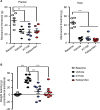Contribution of diacylglycerol lipase β to pain after surgery
- PMID: 29551907
- PMCID: PMC5842774
- DOI: 10.2147/JPR.S157208
Contribution of diacylglycerol lipase β to pain after surgery
Abstract
Background: Metabolism of the endocannabinoid 2-arachidonoylglycerol (2-AG) yields arachidonic acid (AA), the precursor to proalgesic eicosanoids including prostaglandin E2 (PGE2). Diacylglycerol lipase β (DAGLβ) is an enzyme that synthesizes 2-AG and its inhibition reduces eicosanoid levels and produces antinociceptive effects in models of inflammatory pain. Here we test whether inhibition of DAGLβ produces antinociceptive effects in a model of postoperative pain.
Methods: Rats were administered the selective DAGLβ inhibitor KT109 or vehicle and underwent plantar incision. Postsurgical pain/disability was examined using evoked (mechanical hyperalgesia), functional (incapacitance/weight bearing), and functional/spontaneous (locomotion) modalities.
Results: Activity-based protein profiling confirmed that KT109 inhibited DAGLβ in the lumbar spinal cord (LSC) and brain, confirming that it is a systemically active DAGLβ inhibitor. Treatment with KT109 reduced basal 2-AG, AA, and PGE2 levels in the liver but not the brain, indicating that DAGLβ activity does not significantly contribute to basal PGE2 production within the central nervous system. Plantar incision elevated the levels of 2-AG and PGE2 in the LSC. Although KT109 did not alter postsurgical 2-AG levels in the LSC, it slightly reduced PGE2 levels. In contrast, the clinically efficacious cyclooxygenase inhibitor ketoprofen completely suppressed PGE2 levels in the LSC. Similarly, KT109 had no significant effect upon postsurgical 2-AG, AA, or PGE2 levels at the incision site, while ketoprofen abolished PGE2 production at this location. KT109 and ketoprofen reversed the weight bearing imbalance induced by plantar incision, yet neither KT109 nor ketoprofen had any significant effect on mechanical hyperalgesia. Treatment with ketoprofen partially but significantly rescued the locomotor deficit induced by incision while KT109 was without effect.
Conclusion: DAGLβ is not the principal enzyme that controls 2-AG derived AA and PGE2 production after surgery, and inhibitors targeting this enzyme are unlikely to be efficacious analgesics superior to those already approved to treat acute postoperative pain.
Keywords: 2-AG; endocannabinoid; incision; pain; surgery.
Conflict of interest statement
Disclosure The authors report no conflicts of interest in this work.
Figures






Similar articles
-
Liposomal Delivery of Diacylglycerol Lipase-Beta Inhibitors to Macrophages Dramatically Enhances Selectivity and Efficacy in Vivo.Mol Pharm. 2018 Mar 5;15(3):721-728. doi: 10.1021/acs.molpharmaceut.7b00657. Epub 2017 Sep 13. Mol Pharm. 2018. PMID: 28901776 Free PMC article.
-
Inhibition of DAGLβ as a therapeutic target for pain in sickle cell disease.Haematologica. 2023 Mar 1;108(3):859-869. doi: 10.3324/haematol.2021.280460. Haematologica. 2023. PMID: 35615929 Free PMC article.
-
Inhibition of diacylglycerol lipase β modulates lipid and endocannabinoid levels in the ex vivo human placenta.Front Endocrinol (Lausanne). 2023 Feb 14;14:1092024. doi: 10.3389/fendo.2023.1092024. eCollection 2023. Front Endocrinol (Lausanne). 2023. PMID: 36864832 Free PMC article.
-
Alterations in endocannabinoid tone following chemotherapy-induced peripheral neuropathy: effects of endocannabinoid deactivation inhibitors targeting fatty-acid amide hydrolase and monoacylglycerol lipase in comparison to reference analgesics following cisplatin treatment.Pharmacol Res. 2013 Jan;67(1):94-109. doi: 10.1016/j.phrs.2012.10.013. Epub 2012 Nov 2. Pharmacol Res. 2013. PMID: 23127915 Free PMC article.
-
WWL70 protects against chronic constriction injury-induced neuropathic pain in mice by cannabinoid receptor-independent mechanisms.J Neuroinflammation. 2018 Jan 8;15(1):9. doi: 10.1186/s12974-017-1045-9. J Neuroinflammation. 2018. PMID: 29310667 Free PMC article.
Cited by
-
Acute postoperative pain and dorsal root ganglia transcriptomic signatures following total knee arthroplasty (TKA) in rats: An experimental study.PLoS One. 2022 Dec 6;17(12):e0278632. doi: 10.1371/journal.pone.0278632. eCollection 2022. PLoS One. 2022. PMID: 36473007 Free PMC article.
-
Incarvillateine produces antinociceptive and motor suppressive effects via adenosine receptor activation.PLoS One. 2019 Jun 25;14(6):e0218619. doi: 10.1371/journal.pone.0218619. eCollection 2019. PLoS One. 2019. PMID: 31237895 Free PMC article.
-
Effect of Neibu Huangqi Youhua formula on postoperative wound healing, inflammatory factors and pain mediators of anal fistula.J Tradit Chin Med. 2025 Jun;45(3):628-632. doi: 10.19852/j.cnki.jtcm.2025.03.015. J Tradit Chin Med. 2025. PMID: 40524301 Free PMC article. Clinical Trial.
-
Druggable Targets in Endocannabinoid Signaling.Adv Exp Med Biol. 2020;1274:177-201. doi: 10.1007/978-3-030-50621-6_8. Adv Exp Med Biol. 2020. PMID: 32894511 Free PMC article. Review.
-
Bisphenol A Deranges the Endocannabinoid System of Primary Sertoli Cells with an Impact on Inhibin B Production.Int J Mol Sci. 2020 Nov 26;21(23):8986. doi: 10.3390/ijms21238986. Int J Mol Sci. 2020. PMID: 33256105 Free PMC article.
References
-
- Baratta JL, Gandhi K, Viscusi ER. Perioperative pain management for total knee arthroplasty. J Surg Orthop Adv. 2014;23(1):22–36. - PubMed
-
- Bree D, Moriarty O, O’Mahony CM, et al. Development and characterization of a novel, anatomically relevant rat model of acute postoperative pain. J Pain. 2015;16(5):421–435. e421–426. - PubMed
-
- Brennan TJ, Vandermeulen EP, Gebhart GF. Characterization of a rat model of incisional pain. Pain. 1996;64(3):493–501. - PubMed
LinkOut - more resources
Full Text Sources
Other Literature Sources

